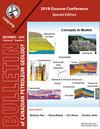不列颠哥伦比亚省Liard盆地Maxhamish湖区白垩系Chinkeh组砂岩的最大年龄
Q3 Earth and Planetary Sciences
引用次数: 2
摘要
Chinkeh组砂岩、页岩和砾岩代表了不列颠哥伦比亚省东北部、育空地区东南部和西北地区西南部Liard盆地白垩系段基底的滨面和水道化环境。生物地层学对其形成的限制表明其形成于豪特里维世至早阿尔贝世。Maxhamish湖区地下岩心U-Pb碎屑锆石年龄表明,该地区最大沉积年龄为112.6±2.0 Ma,为早阿普梯世至晚阿普梯世。颗粒圆度和锆石晶体形态的多样性表明,白垩世锆石主要来源于深部岩浆。在中白垩世,位于Maxhamish湖区西北约550公里处的铁砧套侵入物形成了可能的来源。最初覆盖在侵入体上的几公里长的沉积物的侵蚀至少需要一百万年,而在那之前,深成锆石不会进入沉积物供应。由于深部锆石可用性的延迟,新的碎屑锆石结果表明,Maxhamish Lake地区Chinkeh组的年龄更可能是早阿普梯世,而不是最晚阿普梯世,并支持根据有孔虫划分的早阿普梯世年龄。碎屑锆石年代学已被证明是区分Chinkeh组与类似三叠纪地层的一个非常有用的工具。本文章由计算机程序翻译,如有差异,请以英文原文为准。
Maximum age of the basal Cretaceous Chinkeh Formation sandstones, Maxhamish Lake area, Liard Basin, British Columbia
Sandstone, shale and conglomerate of the Chinkeh Formation represent shoreface and channelized environments forming the base of the Cretaceous section in Liard Basin of northeast British Columbia, southeast Yukon and southwest Northwest Territories. Biostratigraphic constraints on the formation indicated a Hauterivian to Early Albian age. New U-Pb detrital zircon ages obtained from a subsurface core in the Maxhamish Lake area indicate a maximum depositional age of 112.6 ± 2.0 Ma and an Early Albian to latest Aptian age. Grain roundness and the diversity of zircon crystal morphologies suggest that most of the Cretaceous-aged zircons were derived from plutonic sources. Intrusions of the Anvil Suite, located approximately 550 km westnorthwest of the Maxhamish Lake area in the mid-Cretaceous, form the likely source. Erosion of the few kilometres of sediment originally overlying the intrusions would take at least a million years and plutonic zircon would not enter the sediment supply until then. Because of this delay in plutonic zircon availability, the new detrital zircon results suggest that the Chinkeh Formation in the Maxhamish Lake area is more likely Early Albian than latest Aptian in age, and support the Early Albian age assigned on the basis of foraminifera. Detrital zircon geochronology has proven to be a very useful tool in differentiating the Chinkeh Formation from similar Triassic strata.
求助全文
通过发布文献求助,成功后即可免费获取论文全文。
去求助
来源期刊

Bullentin of Canadian Petroleum Geology
Earth and Planetary Sciences-Geochemistry and Petrology
CiteScore
2.50
自引率
0.00%
发文量
0
期刊介绍:
The Bulletin of Canadian Petroleum Geology is a peer-reviewed scientific journal published four times a year. Founded in 1953, the BCPG aims to be the journal of record for papers dealing with all aspects of petroleum geology, broadly conceived, with a particularly (though not exclusively) Canadian focus. International submissions are encouraged, especially where a connection can be made to Canadian examples.
 求助内容:
求助内容: 应助结果提醒方式:
应助结果提醒方式:


